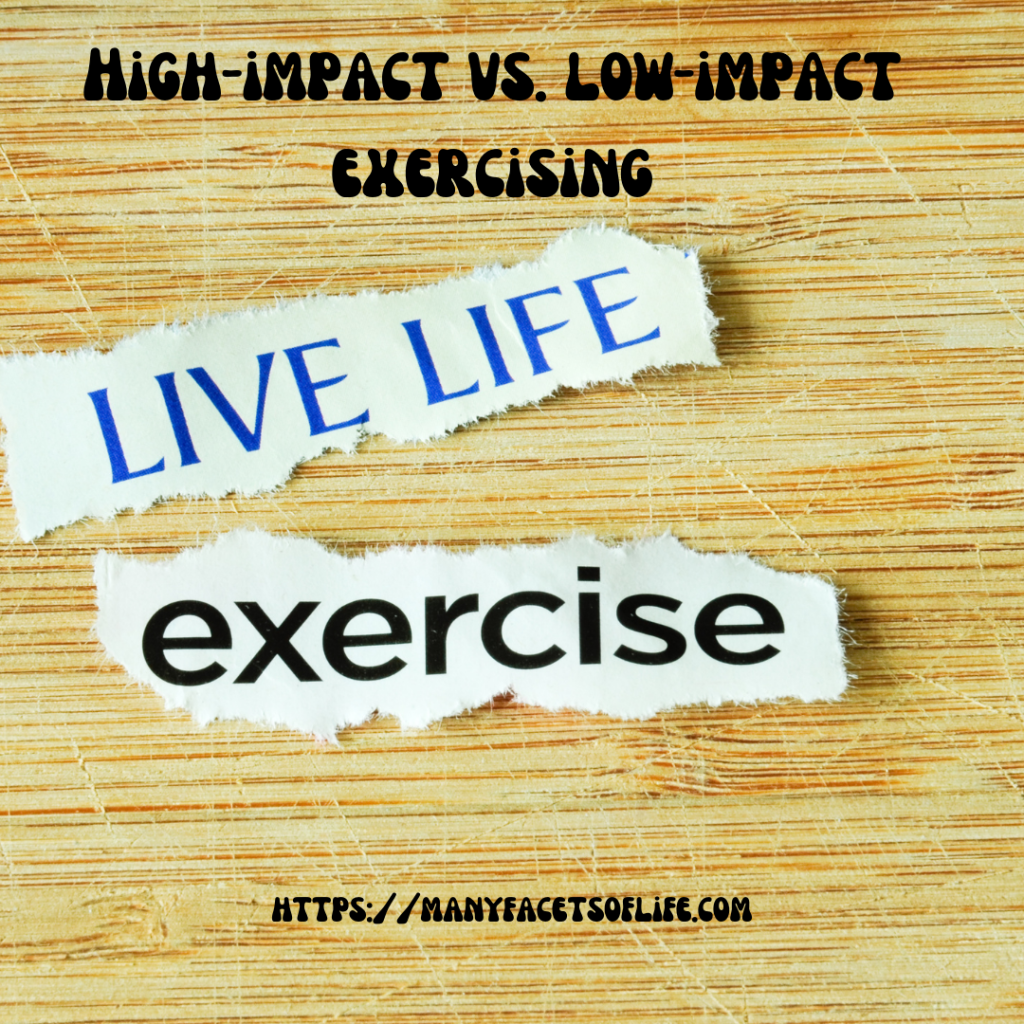
High-impact vs. low-impact exercising
DISCLAIMER: I am not a doctor, physician, or trainer, or giving medical advice. I am creating this post from my own personal experiences, and from the resource links mentioned throughout the post. Always contact your doctor or a certified trainer before you start any exercise regimen or sports activities.
Posts may contain affiliate links. As an Amazon Associate, we earn from qualifying purchases and collect a small commission at no cost to you. This helps my blog to keep going. Thank you! For more info, read my disclosure policy.
When I was younger I did high-impact exercising as my choice of routine regimen. I did Jazzercise almost every day and as time went on I incorporated going to the gym using the equipment to round out my exercise regimen.
I do remember pushing myself at times to the point I would feel pain, but I do not remember any crucial injuries. Now that I am an older adult, I prefer low-impact exercising, as I have osteoporosis and have to find exercises that are gentle on my body and increase my flexibility. My choice now is walking and yoga.
Low-impact exercises can improve your health and fitness and are easier on your joints and highly effective without putting excessive wear and tear on your body. An appropriate goal for you all depends on your present fitness level and what you want to accomplish.
Individuals who are new to working out, pregnant, overweight, or suffering from arthritis should also engage in low-impact exercising. They are also recommended for older adults.
People recovering from an injury should do low-impact exercising until they have healed or are released by their doctor to start doing high-impact exercises.
Low-impact exercises will get your heart going, burn calories and increase your flexibility. It is best to check with your doctor to see what might be best for you.
Those who aren’t in the proper physical condition for high-impact exercises and those who fear wear and tear from such intense exercise should opt for low-impact exercises as they have a lower risk of injury yet they do not allow for rapid muscle growth or bone health improvement.
If your doctor gives you the ok, it is suggested that you incorporate low-impact with high-impact exercising and alternate between the two throughout the week. Be sure to follow what your doctor says about how to mix the two.
If they think low-impact is better all around for you, follow their advice. Just remember to listen to your body and that pain is not a good thing when exercising.
In my post, you will see 6 popular methods for low-impact exercising and how they can benefit you and your workouts: walking, cycling, dancing, swimming/aquatic exercise, yoga, and pilates.
Walking

Walking is considered the most popular low-impact exercise and is my first choice. It is a form of exercise that’s available to most people. You don’t need any special equipment but comfortable and supportive walking shoes.
Health benefits
It works the cardiovascular system, which includes the heart, blood vessels, and blood, and also burns calories. To get your heart rate up, walk faster than a stroll. Picking up the pace can increase the intensity of your workouts.
Walking as a regular activity can help reduce your risk of these common health problems:
- Obesity
- Diabetes
- Heart disease
- High blood pressure
- Depression
Recommended weekly workout minutes
The average American walks 3,000 to 4,000 steps a day or roughly 1.5 to 2 miles. Keep track of how many steps a day you walk and use that as your own baseline. As you build up your stamina set new goals by increasing your steps.
The U.S. Department of Health and Human Services recommends 150 minutes a week of moderate-intensity exercises, such as brisk walking. You can start gradually and increase your activity week by week to the level you want to accomplish or what your doctor recommended.
Your 150 minutes a week can be divided up into different ways. Some people aim for 30 minutes of exercise five days a week, and others do 10 minutes of exercise several times a day.
Do what works for you and your goals. If you aren’t ready for moderate-intensity exercises, you can do all low-impact exercises. Listen to your body and know you can still reach your goals by dividing up your exercise routines throughout the day.
Also, download the Active 10 app on your phone to track your steps and help set your goals!
These are some activities you can do when walking:
- Take the dog for a walk or combine your activity with social time by joining a friend to walk his or her dog.
- Include family or friends in going for a walk or hike together.
- When you are early to an appointment or for a flight, take a walk while waiting by walking through the airport or in the building where your appointment is.
- Pick a time to walk daily in your neighborhood. I am a morning person so I like to walk early morning to get energized for the day ahead.
- If you work from home, be sure to get up and take breaks by taking a short walk. It is amazing how fresh you will be once you get back to work.
- Pick parking spots that are further away and walk to your destination.
- Take the stairs instead of elevators. You can get a great workout and lose calories.
Cycling
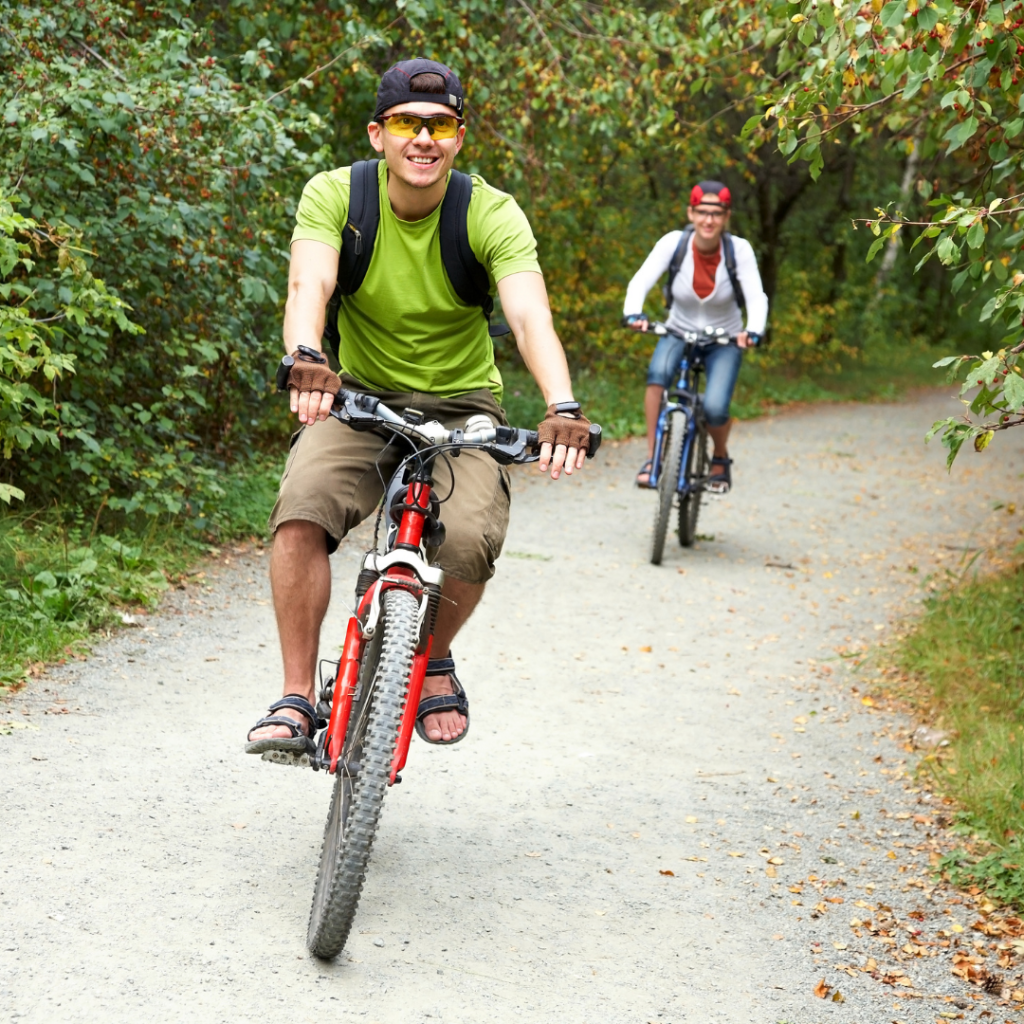
Cycling is more efficient than walking versus possibly working harder than walking briskly and will probably exercise your heart, lungs, and major muscles more than walking. Cycling probably won’t put excessive wear and tear on your hips, knees, and ankles as walking.
It is a low-impact exercise that causes less strain to your joints and muscles and injuries than most other forms of exercise. Cycling involves fluid and controlled movements without jerking, twisting, or constant pounding.
It is a wonderful workout that keeps you active and can help shape a healthy lifestyle, both physically and mentally. Cycling is a great option for people who have joint concerns or overall stiffness, especially in the lower body.
It is a way to raise your heart rate, improve cardiovascular function, and can help keep weight off which may reduce your risk for certain types of cancer. Cycling can be beneficial in balance which can be a prevention of falls and fractures, possibly decreasing your risk of injury and falling.
You can cycle as a means of transportation, riding for fresh air and enjoyment, or for intense competition. You have to deal with traffic and weather conditions, but you can also do cycling at the gym or at home.
A serious disadvantage is the risk of an accident, whether in the city limits or rural areas. Watch for cars at all times, and wear a helmet. If you are riding at night, be sure to wear reflectors so people can see you.
Swimming/Aquatic exercise
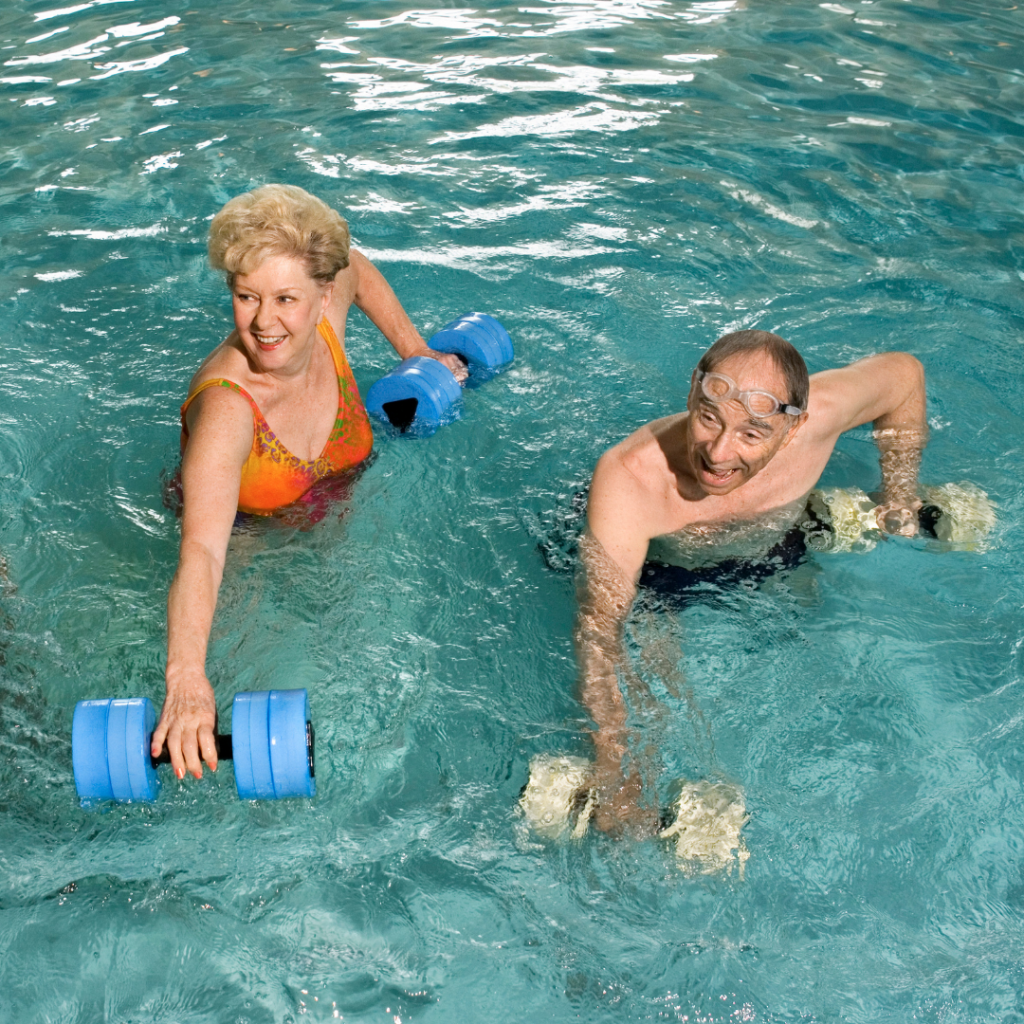
Swimming benefits people with arthritis and seniors
Swimming is a way to fit cardio into your workout routine without putting stress on your bones, joints, and muscles. It is particularly beneficial for seniors and people with arthritis.
One reason a water exercise program is a good choice is if you have arthritis water is buoyant and supports your body, so there is less impact on your joints.
The second reason is that if you exercise in a heated pool, the warmth helps soothe sore joints.
The third reason is when you move your body through water it creates a natural resistance giving your muscles a good workout without the need for weights.
It keeps your heart rate up, builds endurance, muscle strength, flexibility, and cardiovascular fitness, and helps you maintain a healthy weight, healthy heart, and lungs.
Remember to check with your doctor before you attempt any form of exercise or a new activity.
Centers for Disease Control and Prevention, CDC
According to the Centers for Disease Control and Prevention (CDC) it’s especially helpful for people who have joint conditions, such as osteoarthritis and rheumatoid arthritis.
It’s also a gentler form of exercise for pregnant women and people who have:
Swimming/aquatic equipment you might need
If you attend an aquatic/swim class at a fitness center, the facility will likely provide any equipment that you need. Some pools may even have water treadmills, ellipticals, and bikes. Be sure to bring a swim cap, a pair of goggles, and a towel.
Here are some equipment items you might be interested in getting before you take a class:
- Wrist or ankle weights
- Foam dumbbells
- Hand paddles
- Resistance gloves
- Kickboard
- Buoyancy belt
Walking in water can target your arms, core, and lower body, and you can increase the intensity by using hand or ankle weights.
A Water aerobics class lasts an hour. An instructor will lead you through a series of moves, often set to music to keep you motivated.
Here is a link to a slide show with 6 aquatic exercises through Mayo Clinic that you can do.
Dancing
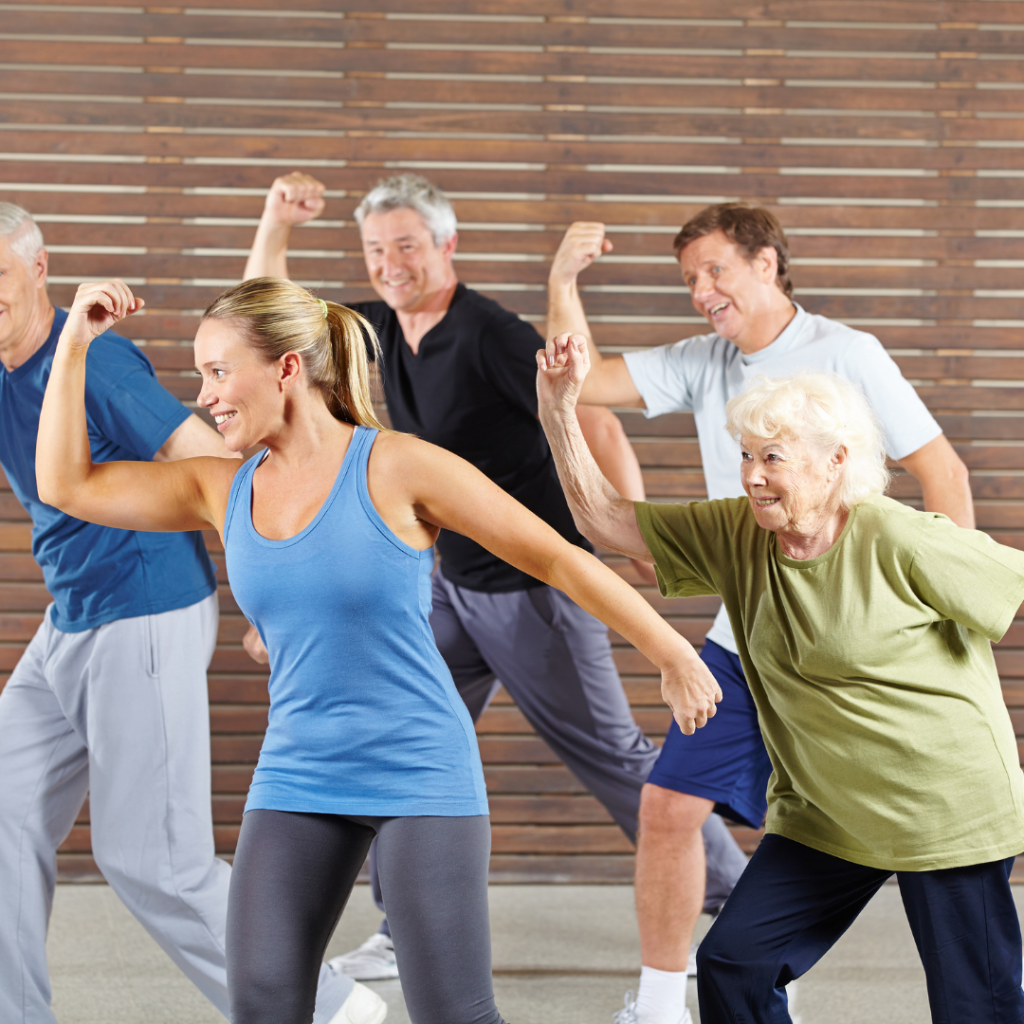
Benefits for beginners and seniors
Dancing workouts are a healthy and fun way to meet new people and socialize, with plenty of benefits. Line dancing is popular with seniors.
A low-impact dance cardio workout will get your heart rate up while moving your muscles and joints for better balance, coordination, and strength, and so it is beneficial for beginners and seniors. You’ll still get a great workout without jumping, skipping, and hopping.
Other health benefits from dancing for seniors:
- Improves your cardiovascular health, which will decrease your chances of developing heart disease.
- It prevents or delays diseases, such as diabetes, or osteoporosis.
- It can improve your mood and fights off depression.
- Dancing is the one activity that is good for the mind, significantly reducing the risk of getting dementia.
- Increases energy levels. by stimulating the feel-good hormones like serotonin and endorphins, which make you more energized.
- Better weight management. Dancing works on the whole body which results in calories being burned off.
- Improved bone health. Movement enhances your bone strength as it increases bone mass.
Here is a link to Livestrong.com with a low-impact cardio dance workout you can try.
Dance classes are usually taught in a studio, so find out from your doctor first so they can guide you on what is best for you depending on your physical health. Then find a reputable dance studio that has the style of dance that will work for you.
Web MD also has tips and information on dancing workouts.
You can also go to YouTube for videos that you can do at home.
Yoga
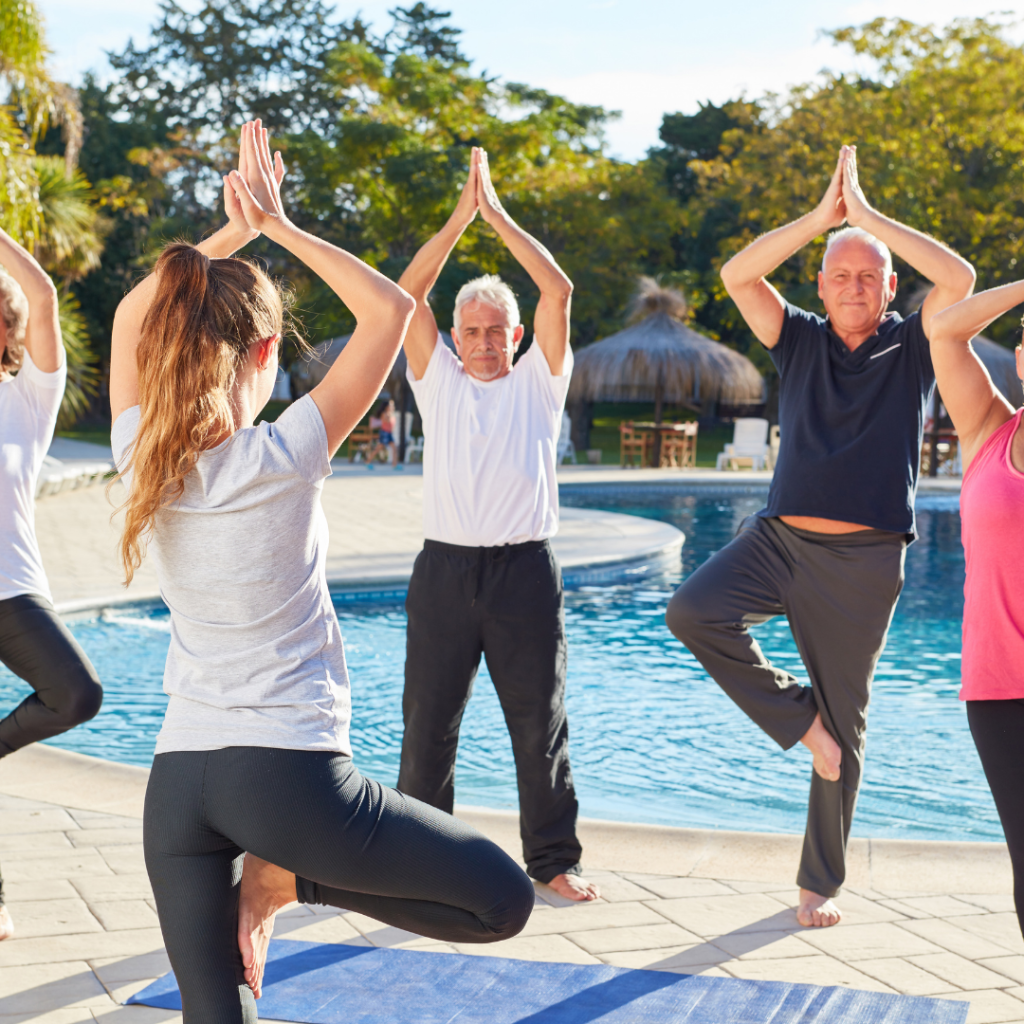
Yoga isn’t just a physical experience as it is a combination of breathing and connecting with our body, mind, and soul. It has become very popular and has a wide variety of different poses, so there is a version that will work for everyone.
This is something you can do alone, in a class, or at home with family and friends. It is considered a low-impact exercise. There are different poses that can take more energy and work, so be sure to check with your doctor and see which pose will work for you before you start.
I find yoga relaxing and a way to relieve stress, so it is one of my favorite ways to work out.
Benefits of Yoga
- Improves flexibility, muscle strength, and balance
- Improves energy
- Maintaining a balanced metabolism
- Cardio and circulatory health
- Protection from injuries
- Helps with stress relief
- Improves mental health
- Helps decrease anxiety
Here are Kaiser Permanente’s 6 simple yoga poses to get you through your day!
- Mountain Pose
- Upward Salute
- Salutation Seal
- Cow Face Pose
- Cat Pose
- Child’s Pose
Be sure to have a yoga mat ready and water to keep you hydrated. These can help you get started and then you can check out other poses that might work for whatever is ailing you.
Poses for seniors
- Mountain Pose – helps with balance
- Tree Pose – excellent for leg and abdominal strength, and good for balance and concentration
- Bird Dog – good for abdominals and back support
- Downward Facing Dog – great for joint health, flexibility, and all-over body strength
- Sphinx – excellent for upper back strength and preventing forward head syndrome
- Cobbler’s Pose – a great way for seniors to keep their hips open and massage their feet
- Savasana – resets the nervous system and helps with restoring peace to the body and mind
Poses for beginners
- Hatha Yoga – basics, slow-moving class
- Yin Yoga – calm and balance your body and mind, this is where you’ll find your zen
- Restorative Yoga – mellow, slow-moving practice with longer holds
- Easy Pose – strengthens back and abdominal muscles
- Child’s Pose – stretches the back, hips, and arm muscles as well as calms the nervous system
- Tree Pose – excellent for leg and abdominal strength, and good for balance and concentration
I think you will like what yoga brings to your life, health, and fitness. You will see why it is so popular and has so many benefits.
“Motivation is what gets you started. Habit is what keeps you going.”
-Jim Ryun
Pilates
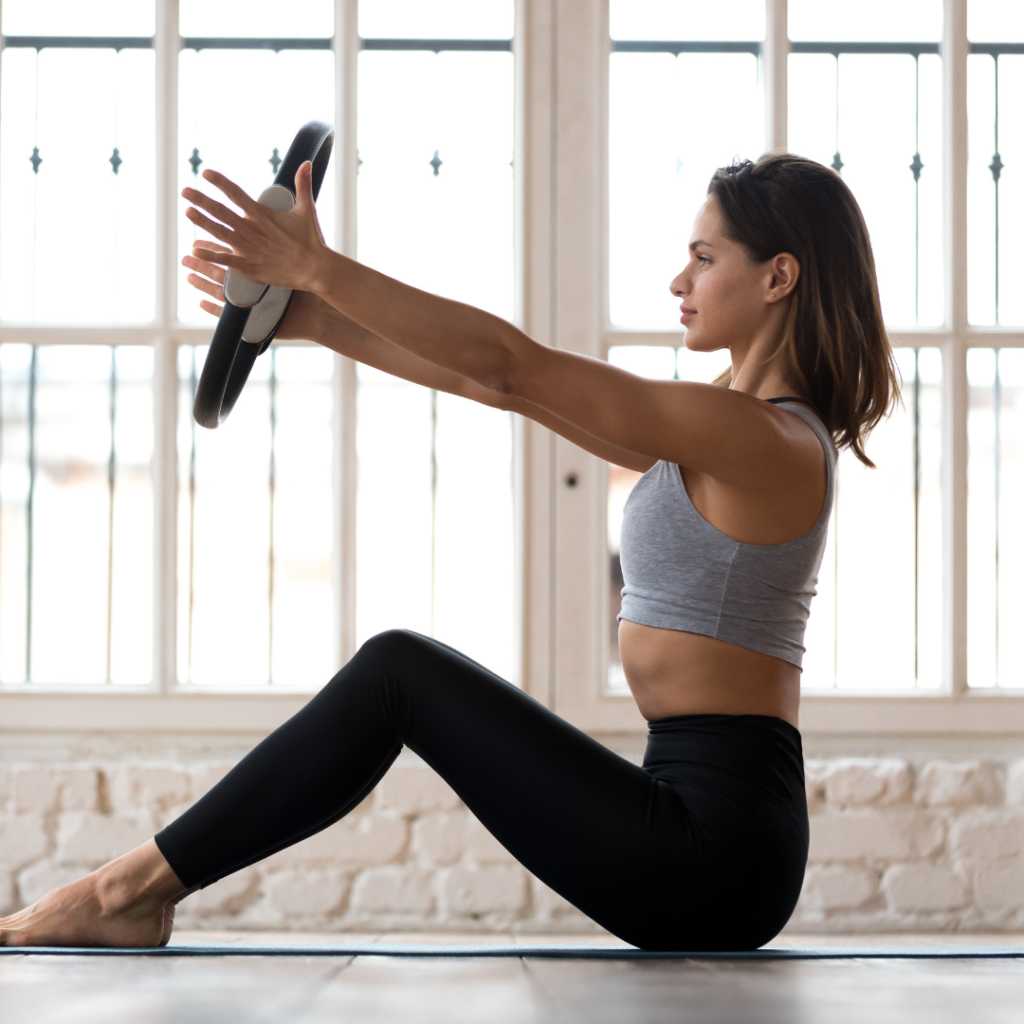
Pilates is a popular low-impact exercise that is designed to strengthen the body. It’s effective for toning up, building lean muscle, and improving posture. Practicing Pilates can be beneficial for your health and help you maintain a healthy weight.
Can be done with or without equipment. It is not an aerobic exercise so you will need to add cardio to your workout.
Benefits of pilates
Workouts help improve flexibility, balance, and core strength, and are effective if you suffer from back pain and boost functional movement.
- Improves muscular endurance, strengthens muscle tissue, and core strength
- Increases flexibility and range of motion
- Can improve posture and stability
- Can be done after injury or as part of physical rehabilitation therapy
Types of pilates
Pilates involves a group of precise, controlled exercises developed by Joseph Pilates to help him overcome his physical issues that resulted from childhood ailments. The type of Pilates that’s best for you depends on what your goals and personal preferences are.
Here are the different types of Pilates:
- Classical Pilates – (also known as Traditional Pilates, Authentic Pilates, Roman Pilates, and Real Pilates) Exercises are often done in a particular order. Both mat and apparatus ( to help accelerate the process of stretching, strengthening, body alignment, and increased core strength started by the Mat work), are incorporated and include transitions between the exercises. A piece of the Pilates apparatus is called a Pilates Reformer.
- Mat Pilates – focuses on your core, making it beneficial for those with back pain. The exercises in mat Pilates are performed with your body and a yoga mat.
- Reformer Pilates – offers similar core-strengthening benefits to mat Pilates, but uses a Pilates Reformer.
- Contemporary Pilates – each class varies depending on the type of school that each Pilates instructor goes through and what style they prefer to teach. These exercises are typically based on contemporary research. Polestar, for example, is a contemporary approach. Polestar Pilates Website
- Stott Pilates – each class begins with a warm-up to align the body and release neck and back pressure. Props such as the stability ball and foam roller are added.
- Winsor Pilates – shaping the body with a combination of classical Pilates exercises done in a specific, nontraditional order to maximize results.
Pilate Exercises for Beginners
Equipment you can incorporate into a pilates exercise:
Pilates can be done with or without equipment depending on what exercise you decide to do.
- Pilates Reformer
- Stability ball
- Foam roller
- Pilates Mats – See Sport’s Illustrated top choices.
- Pilates Arc/Step Barrel
- Pilates Ring
Pilate benefits for seniors
Pilates, with all of its variety and modifications, is a great low-impact form of exercise for seniors.
- Pilates is gentle and can be modified – easy on the joints, can be modified for the needs of seniors with osteoporosis, high blood pressure, diabetes, or other conditions.
- Heightens body awareness and helps prevent falls – there is attention to increased coordination and stability which is important for seniors as it can help improve balance while standing and walking. Doing Pilates creates strength and flexibility in both the core and the legs, which affects balance in a positive way.
- Improves and maintains mobility – physical benefits of Pilates enable seniors to improve and maintain mobility, which helps keep them stronger and can put them in good spirits.
- Lessens the effects of debilitating medical conditions – Pilates can slow down medical conditions, such as osteoporosis, and help delay the onset of Alzheimer’s and other forms of dementia, which the slowing of progression can improve their quality of life.
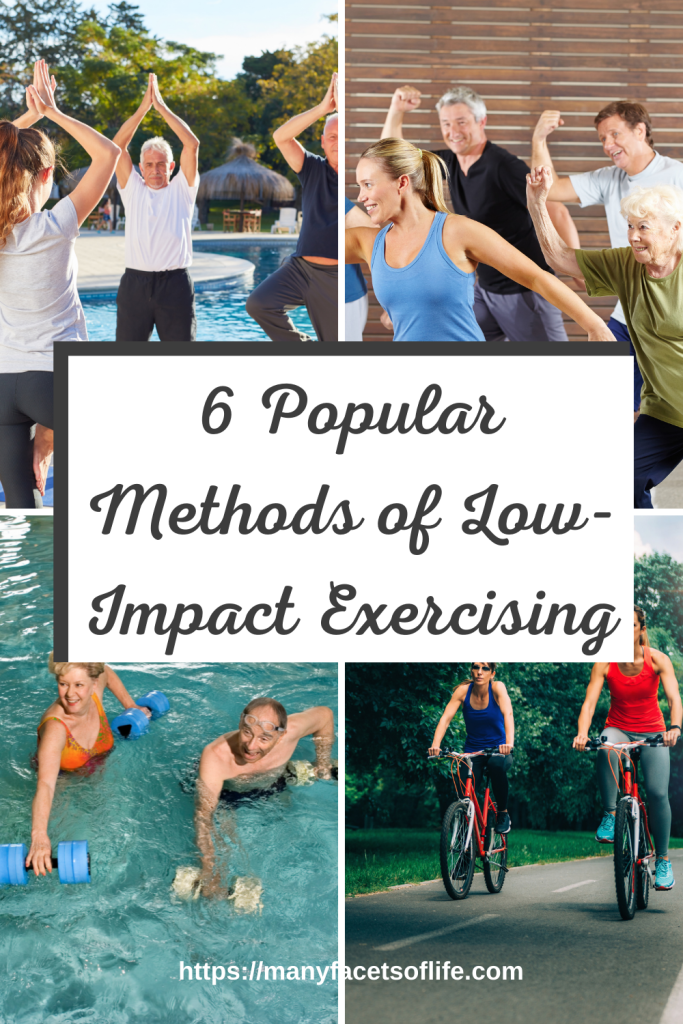
Final thoughts
I have given the details on 6 low-impact ways to exercise. Be sure to check with your doctor or medical professional to see what they advise for you depending on your weight, medical conditions, and age.
When you start, know that you can incorporate another form. For instance, Pilates is not an aerobic exercise so you should find a cardio exercise to do with it, approved by your physician that you will like.
Since it is possible to mix and match some exercises, try several that were approved for high-impact and low-impact exercises, depending on your physical and medical condition. The more you enjoy something, the more likely you will stick with it.
Remember not to overdo it and modify the exercise when needed to prevent injuries. If you are feeling pain, stop immediately and call your physician to see what to do.
If you found this post helpful, please share it with family and friends and on social media. Scroll down to the comment section as comments are appreciated.
Below you will see the equipment you can use in some pilate exercises on Amazon. They are highly recommended.
Here is another post you might find useful – How To Prevent Injuries When Exercising
Subscribe to my YouTube Channel
Visit my podcast Health Becomes Fitness
Join my email list for my free newsletter and other posts on the right sidebar.
See you soon, Denise
DISCLAIMER: I am not a doctor, physician, or trainer, or giving medical advice. I am creating this post from my own personal experiences, and from the resource links mentioned throughout the post. Always contact your doctor or a certified trainer before you start any exercise regimen or sports activities.
Posts may contain affiliate links. As an Amazon Associate, we earn from qualifying purchases and collect a small commission at no cost to you. This helps my blog to keep going. Thank you! For more info, read my disclosure policy.

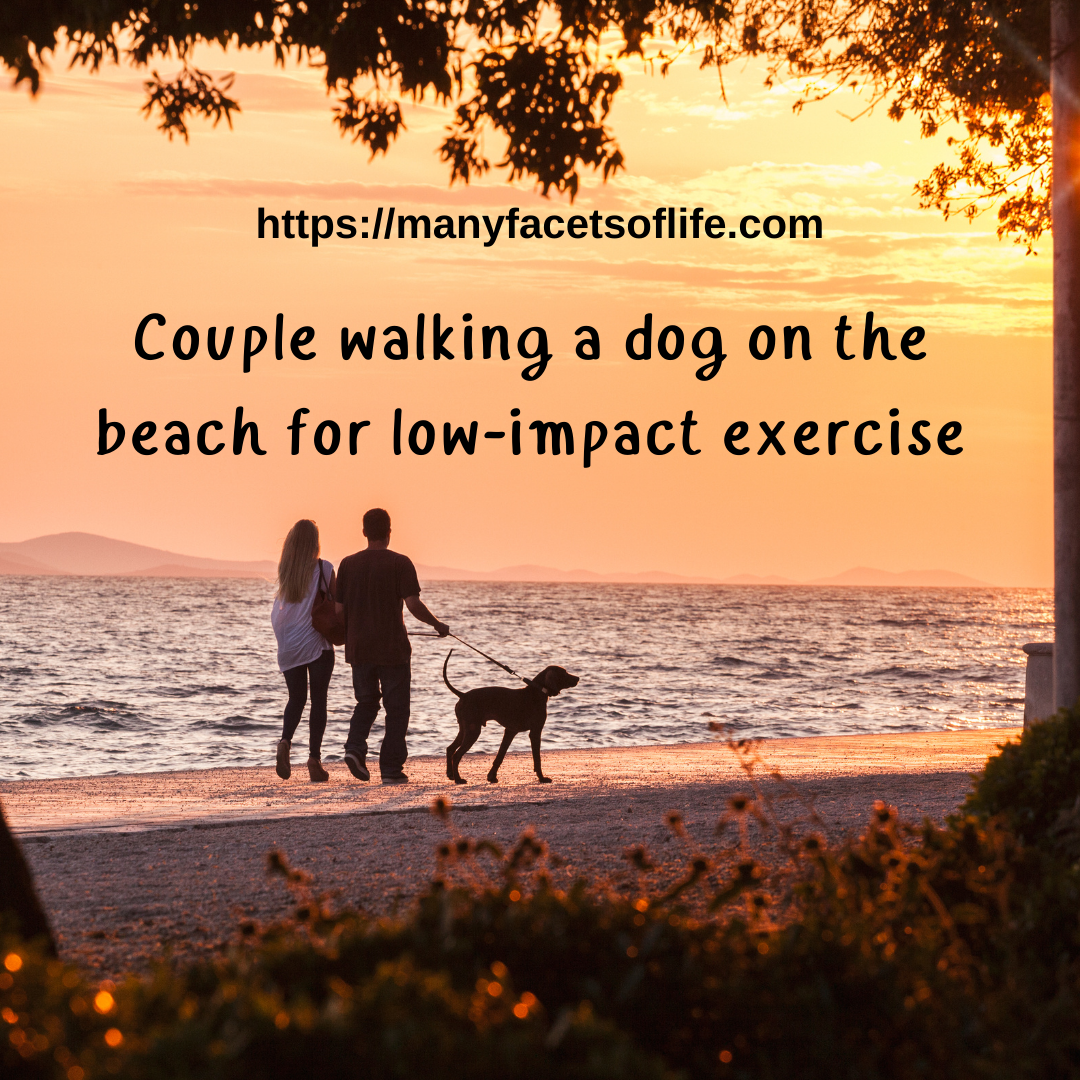

This is a great post, Denise! I love the recommendation that people try yoga, it can be such a nice way to get exercise while practicing mindfulness.
I love these activities and try to incorporate in my running to avoid injuries and to strengthen my core too.
Walking and biking are my favorites and I typically like to alternate between the two. I recently purchased a new bike and now that Spring is here, I’m looking forward to stepping up my workout routine.
Great suggestions. I try to balance more low impact to break up my long days and relieve stress. Might go for a quick walk around the block now.